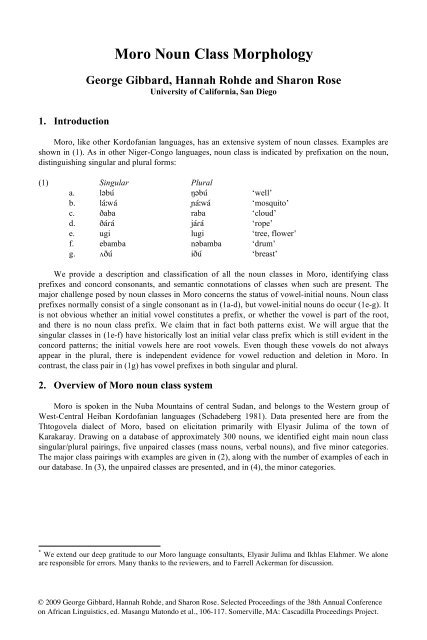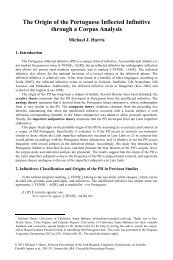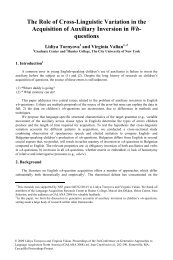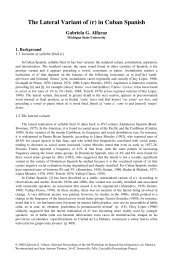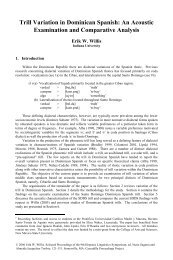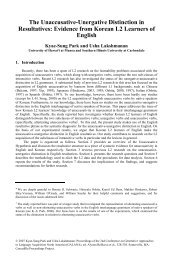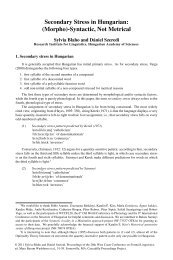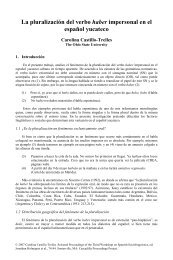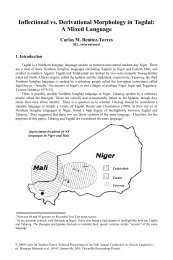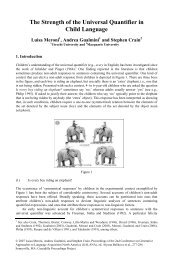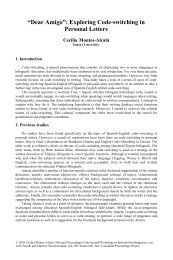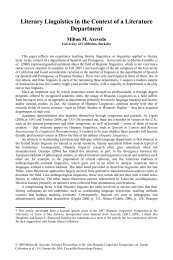Moro Noun Class Morphology - Cascadilla Proceedings Project
Moro Noun Class Morphology - Cascadilla Proceedings Project
Moro Noun Class Morphology - Cascadilla Proceedings Project
Create successful ePaper yourself
Turn your PDF publications into a flip-book with our unique Google optimized e-Paper software.
1. Introduction<br />
<strong>Moro</strong> <strong>Noun</strong> <strong>Class</strong> <strong>Morphology</strong><br />
George Gibbard, Hannah Rohde and Sharon Rose<br />
University of California, San Diego<br />
<strong>Moro</strong>, like other Kordofanian languages, has an extensive system of noun classes. Examples are<br />
shown in (1). As in other Niger-Congo languages, noun class is indicated by prefixation on the noun,<br />
distinguishing singular and plural forms:<br />
(1) Singular Plural<br />
a. lbu bu ‘well’<br />
b. lawa awa ‘mosquito’<br />
c. aba raba ‘cloud’<br />
d. aa jaa ‘rope’<br />
e. ugi lugi ‘tree, flower’<br />
f. ebamba nbamba ‘drum’<br />
g. u iu ‘breast’<br />
We provide a description and classification of all the noun classes in <strong>Moro</strong>, identifying class<br />
prefixes and concord consonants, and semantic connotations of classes when such are present. The<br />
major challenge posed by noun classes in <strong>Moro</strong> concerns the status of vowel-initial nouns. <strong>Noun</strong> class<br />
prefixes normally consist of a single consonant as in (1a-d), but vowel-initial nouns do occur (1e-g). It<br />
is not obvious whether an initial vowel constitutes a prefix, or whether the vowel is part of the root,<br />
and there is no noun class prefix. We claim that in fact both patterns exist. We will argue that the<br />
singular classes in (1e-f) have historically lost an initial velar class prefix which is still evident in the<br />
concord patterns; the initial vowels here are root vowels. Even though these vowels do not always<br />
appear in the plural, there is independent evidence for vowel reduction and deletion in <strong>Moro</strong>. In<br />
contrast, the class pair in (1g) has vowel prefixes in both singular and plural.<br />
2. Overview of <strong>Moro</strong> noun class system<br />
<strong>Moro</strong> is spoken in the Nuba Mountains of central Sudan, and belongs to the Western group of<br />
West-Central Heiban Kordofanian languages (Schadeberg 1981). Data presented here are from the<br />
Thtogovela dialect of <strong>Moro</strong>, based on elicitation primarily with Elyasir Julima of the town of<br />
Karakaray. Drawing on a database of approximately 300 nouns, we identified eight main noun class<br />
singular/plural pairings, five unpaired classes (mass nouns, verbal nouns), and five minor categories.<br />
The major class pairings with examples are given in (2), along with the number of examples of each in<br />
our database. In (3), the unpaired classes are presented, and in (4), the minor categories.<br />
* We extend our deep gratitude to our <strong>Moro</strong> language consultants, Elyasir Julima and Ikhlas Elahmer. We alone<br />
are responsible for errors. Many thanks to the reviewers, and to Farrell Ackerman for discussion.<br />
© 2009 George Gibbard, Hannah Rohde, and Sharon Rose. Selected <strong>Proceedings</strong> of the 38th Annual Conference<br />
on African Linguistics, ed. Masangu Matondo et al., 106-117. Somerville, MA: <strong>Cascadilla</strong> <strong>Proceedings</strong> <strong>Project</strong>.
(2) Table of the main class pairings<br />
<strong>Class</strong><br />
Initial<br />
segment<br />
g/l V g-/k<br />
Concord<br />
segment<br />
g/n V g-/k-<br />
j/j low V- j-, k-, s-<br />
l/ l-/- l-<br />
l/ l-/- l-<br />
/ - -<br />
/r - -<br />
/j - -<br />
Singular<br />
eaja<br />
u<br />
oa<br />
emrtá<br />
ajén<br />
úní<br />
lara<br />
lbú<br />
lawata<br />
láwá<br />
eá<br />
usí<br />
aba<br />
ápá<br />
amala<br />
áá<br />
(3) Table of the main unpaired classes<br />
<strong>Class</strong><br />
Initial<br />
segment<br />
Concord<br />
segment<br />
g V g-/k-<br />
j V-/s j-, k-, s-<br />
- -<br />
<br />
b/p, m,<br />
<br />
-<br />
- -<br />
Singular<br />
eéa<br />
áálá<br />
ibg<br />
aeja<br />
ágá<br />
gárá<br />
mgwátá<br />
báá<br />
wára<br />
vléa<br />
Initial<br />
segment<br />
l- l-<br />
n- n-<br />
higher<br />
V-<br />
- -<br />
- -<br />
- -<br />
r- r-<br />
j-/front<br />
V-<br />
Initial<br />
segment<br />
Concord<br />
segment<br />
j-,s- j<br />
Concord<br />
segment<br />
* * *<br />
* * *<br />
* * *<br />
* * *<br />
* * *<br />
Plural Gloss #<br />
laja<br />
l<br />
na<br />
nmrtá<br />
ején<br />
iúní<br />
ara<br />
bú<br />
awata<br />
áwá<br />
eá<br />
usí<br />
raba<br />
rápá<br />
jamala<br />
jáá<br />
‘poor person’<br />
‘worm’<br />
‘milk pot’<br />
‘horse’<br />
‘mountain’<br />
‘hearthstone’<br />
‘stick’<br />
‘well’<br />
‘water cup’<br />
‘mosquito’<br />
‘girl’<br />
‘chick’<br />
‘cloud’<br />
‘friend’<br />
‘camel’<br />
‘rope’<br />
Plural Gloss #<br />
‘sand’<br />
‘haze’<br />
‘fog’<br />
‘liver’<br />
‘sap’<br />
‘salt’<br />
‘peanut’<br />
‘cotton’<br />
‘to write’<br />
‘to pull’<br />
(4) Table of the minor categories<br />
<strong>Class</strong><br />
Initial<br />
segment<br />
Concord<br />
segment<br />
Example<br />
Initial<br />
segment<br />
Concord<br />
segment<br />
Example Gloss #<br />
j/ V j-, k- úlí - - úlí ‘termite’ 1<br />
l/j l- l- lá front V- j, s- eá ‘tooth’ 1<br />
r/j r- r- rlo front V- j-, s- ego ‘f. goat’ 4<br />
/g - - rlí round V k/g- urlí ‘root’ 5<br />
l l- l- lájá * * ‘honey’ 1<br />
These classes are highly similar to the noun classes identified by Black & Black (1971) and Guest<br />
(1997) in their study of the Umm Dorein dialect of <strong>Moro</strong>. In both dialects, apart from a handful of<br />
irregular nouns, consonant-initial nouns have one of a limited set of class prefixes: /l-, -, -, -, n-,<br />
r-, l-, j-/. <strong>Class</strong> concord markers are the same set of prefixes and additionally /g-/, which is used with<br />
many vowel-initial nouns as well as a few g-initial irregular nouns. 1 Categories using these class<br />
concord markers are some but not all tense-aspect-mood forms of verbs, adjectives, numerals and other<br />
quantifiers, demonstratives, possessives and the instrumental case suffix. The sentences in (5) illustrate<br />
1<br />
The segment /g/ is normally voiceless utterance-initially, but voiced in sandhi; still it contrasts with /k/ which<br />
does not alternate.<br />
107<br />
33<br />
64<br />
30<br />
27<br />
24<br />
12<br />
12<br />
13<br />
15<br />
11<br />
24<br />
15<br />
....
108<br />
concord marking. The possessive and demonstrative markers for j- and g- are the allomorphs [s-] and<br />
[k-] respectively 2 , as shown for the demonstratives in (5b) and (5d).<br />
(5) <strong>Noun</strong> class concord<br />
a. -ní-í -e-t-a -ob-o (/ class pair)<br />
CL-dog-CL.DEM CL-REL-small-ADJ CL-run-PRFV<br />
‘This small dog ran away.’<br />
b. uí-kí g-e-t-a g-ob-o (g/l class pair)<br />
CL-dog-CL.DEM CL-REL-small-ADJ CL-run-PRFV<br />
‘This small man ran away.’<br />
c. -amal-í -e-t-a<br />
-ob-o<br />
CL-camel-CL.DEM CL-REL-small-ADJ CL-run-PRFV<br />
‘This small camel ran away.’<br />
(/j class pair)<br />
d. j-amal-sí j-e-t-a<br />
j-ob-o<br />
CL-camel-CL.DEM CL-REL-small-ADJ CL-run-PRFV<br />
‘These small camels ran away.’<br />
(/j class pair)<br />
Stevenson (1956-7) proposed a Bantu-like system of numeral labels for noun classes for the<br />
Kordofanian system as a whole. Our classes do not correspond one-to-one with Stevenson’s, entailing<br />
gaps and additions to accommodate our data. Instead, we will refer to the patterns of paired noun<br />
classes (‘genders’) by their concord segments, so that for example the first pattern given in (2), vowelinitial<br />
singular nouns with l-initial plurals, belong to the class pairing g/l. This allows us to abstract<br />
away from the problem of the initial segment on the nouns themselves.<br />
A summary of the major concord consonant class pairings is shown in (6). <strong>Class</strong> marking does not<br />
necessarily unambiguously identify whether a form is singular or plural: class markers l-, - and j-<br />
(~s-) are common for both singulars and plurals. There is also a minor class with singular r- and one<br />
with plural g-~k-, not shown in (6). Hence only - is exclusively singular and only n- and - are<br />
exclusively plural. This formal overlap is a feature of other Kordofanian languages as well (Norton<br />
2000:25-26).<br />
(6) Singular Plural<br />
g~k l<br />
n<br />
l <br />
<br />
r<br />
j~s j~s<br />
Vowel-initial nouns (both singular and plural) are divided between concord classes g~k and j~s.<br />
Their behavior is illustrated in (7) with examples of three nominal forms; the consonant-initial form<br />
nandme ‘fleas’ is shown for comparison. As mentioned, the allomorphs [k] and [s] of concord<br />
markers g- and j- are used in a subset of concord environments, including demonstratives.<br />
2 In the Umm Dorein dialect (Black & Black 1971), the l- class has the allomorph [ld] in these environments<br />
(demonstrative ildi ‘that/those’), while the g-class has igi ‘that/those’
(7) C-initial V-initial g/l V-initial j/j class - V-initial j/j class -<br />
(or g/n class) singular plural<br />
‘fleas’ ‘flea’ ‘mountain’ ‘mountains’<br />
a. Instrumental nándmé-ná ándmé-gá ajen-ja ejen-ja<br />
b. Demonstrative nándmé-ní ándmé-ki ajen-sí ejen-sí<br />
c. Locative (‘inside’) e-nándmé ék-ándmé ek-ajen es-ején<br />
Locative forms (7c) present a complication. The locative case marker is usually a vowel prefix e-,<br />
as in the form e-nandme ‘in the fleas’; however vowel-initial nouns have an additional consonant,<br />
either [k] or [s]: ek-andme ‘in the flea’ The [k] is used in the g/l and g/n classes, and the [s] is used in<br />
the plural of the j/j class, matching the concord consonants in the demonstrative. However, singular<br />
vowel-initial nouns in the j/j/ class use [k], which does not appear anywhere else as a concord marker<br />
for these words. For this reason, it may be best to treat the inserted consonant in locatives as something<br />
other than class concord.<br />
3. Semantics<br />
Previous research on Kordofanian noun classes (Stevenson 1956-7, Schadeberg 1981, Guest 1997,<br />
Norton 2000) identified a number of different classes, many of which occur in <strong>Moro</strong>. In the chart in (8)<br />
we compare our classification with Guest’s for Umm Dorein <strong>Moro</strong>, and Stevenson’s (1956-57) for the<br />
Koalib-<strong>Moro</strong> group (equivalent to the Schadeberg’s Heiban group). The semantic properties listed may<br />
apply to some members of each class. Some classes include a range of nouns with no clear semantic<br />
connection.<br />
(8) Comparison table of noun classifications<br />
Concord segments Semantic properties<br />
Gibbard et Guest Stevenson Gibbard Guest Stevenson<br />
al.<br />
et al.<br />
g/l g/l 1.kw(u)-, gw(u)-<br />
2. l(i)people<br />
people people<br />
unattested unattested 3. kw(u)-, gw(u)-<br />
4. c-, j-, yn/a<br />
n/a nature<br />
l/ l, lr, r, 5. l(i)-<br />
round, long long, hollow, unit/mass<br />
6. w(u)- things, fruit deep, round<br />
see g/n see g/n 7. k-<br />
8. j-, yn/a<br />
n/a<br />
/r /r 9. t-, d-<br />
some animals, long things long things<br />
10. d-, r- long things<br />
/j /j 11. t-, d-<br />
12. c-, j-, y-<br />
? harmful, large harmful, large<br />
g/n g/n 13. k-, g-<br />
14. ny-, n-<br />
? common things hollow, deep<br />
/ /15. -<br />
16. nysmall<br />
animals small animals small animals<br />
unattested unattested 15a. t-, tr- n/a n/a diminutive<br />
unattested unattested 17. - n/a n/a augmentative<br />
109
110<br />
Comparison table of noun classifications (cont.)<br />
Concord segments Semantic properties<br />
Gibbard et Guest Stevenson Gibbard Guest Stevenson<br />
al.<br />
et al.<br />
19. t()-, ()- infinitive, abstract nouns, infinitive<br />
abstract, nature emotions<br />
20. - liquids, mass liquids, abstract liquids, abstract<br />
nouns<br />
nouns<br />
r/j r/j 21. -<br />
22. y-, jgoat,<br />
etc. goat, etc. goat, etc.<br />
l/ j<br />
unattested 23. l-<br />
24. y-, jtooth<br />
n/a eye, etc.<br />
j/j j/j 25. vowel<br />
26. y-, j-, i-<br />
? foreign words miscellaneous<br />
l/ l/ unattested animals, body animals and n/a<br />
parts, objects body parts<br />
/g /g unattested derivatives of trees, parts of n/a<br />
trees<br />
trees<br />
3.1. Semantic cohesion<br />
Though members of a class may share semantic properties, class membership does not guarantee<br />
semantic relatedness to other members of the class. For example, although the class g/l is the human<br />
class, it also contains nonhumans like ui ‘rat’. In addition, semantically related words may appear in<br />
different classes, so among humans, ea ‘girl/child’ is in the / “small animals” class and lga<br />
‘(my) mother’ is in the l/ “animals-and-body-parts” class.<br />
3.2. Phonological impact on class membership<br />
<strong>Noun</strong>s with an initial consonant that is not one of the noun class prefixes typically use the concord<br />
consonant that is phonologically most similar; some examples are given in (9). Note that the word<br />
sweja is assigned to the j-class, as this class employs s- as a concord consonant in some forms such as<br />
the demonstrative.<br />
(9) Word <strong>Class</strong> Meaning<br />
a. sweja j- ‘a kind of dance’ (cf. demonstrative ísí)<br />
b. gwndu j- ‘axe’<br />
c. t()mbílí - ‘automobile’ (Arabic < English)<br />
Labial-initial nouns (10a-b) use - as the concord consonant, and lack distinct plural forms, even if<br />
semantically one might expect them to be countable nouns, and they do appear with numerals. While<br />
there is no apparent phonological reason for this pattern, it is probably relevant that <strong>Moro</strong> has no labial<br />
class markers. This suggests that where other factors fail, - is used as the default concord consonant.<br />
This appears supported by (10c), which has a velar-initial segment, but for our consultant has concord<br />
in order to distinguish it from a homophonous personal name (which uses concord g- as<br />
should be expected both phonologically and semantically).<br />
(10) Word <strong>Class</strong> Meaning<br />
a. bti - ‘clarified butter’ (cf. Asheron bdi – Norton 2000)<br />
b. mgwata - ‘peanut’<br />
c. ku - ‘ball’ (< Arabic)<br />
d. mao g- ‘guy/man’
The word in (10d) mao ‘guy/man’ is our only example of a labial-initial noun that has g- concord<br />
instead of -. However, mao ‘guy/man’ is our only example of a labial-initial noun with human<br />
reference; assignment to the g- concord class makes sense if we regard - as default for non-humans<br />
and g-/l- as default for humans. For all the examples in (10), semantics would determine class<br />
membership when phonological factors fail to do so.<br />
4. Vowel-initial nouns<br />
Recall that class concord is always marked with a consonant, but nouns themselves can be vowelinitial.<br />
The main analytical problem posed by the vowel-initial forms is whether the vowel is a noun<br />
class prefix or part of the root. Vowel prefixes are not common in Kordofanian languages, attested<br />
with certainty only in the closely related language Tira (Stevenson 1942, 1956-7). There are a few<br />
unclear cases reported in other languages: Otoro a-/- reported in Stevenson (1943), but not confirmed<br />
by Schadeberg (1981), and Warnang a-/c- reported in Schadeberg (1981).<br />
We will now examine each of the <strong>Moro</strong> vowel-initial classes in turn, describing their<br />
characteristics and determining the status of the initial vowel, using <strong>Moro</strong> phonological patterning and<br />
historical evidence. The vowel-initial nouns occur in three main class pairings and two non-paired<br />
classes, repeated from (2).<br />
(11)<br />
<strong>Class</strong><br />
Initial<br />
segment<br />
Concord<br />
segment<br />
Singular<br />
Initial<br />
segment<br />
Concord<br />
segment<br />
Plural Gloss #<br />
j/j low V j- s- (-k-) ajen higher V j-, s- ejen ‘mountain’ 30<br />
/j - - amala j-/front V- j- jamala ‘camel’ 13<br />
g/n V g- -k- oa n- n- na ‘milk pot’ 64<br />
g/l V g- -k- evaja l- l- lvaja ‘poor person’ 33<br />
j V/s j- -s- (-k-) ibg * * * ‘fog’ 11<br />
g V g- -k- evea * * * ‘sand’ 15<br />
4.1. The j/j and /j classes<br />
In Stevenson’s chart of Koalib-<strong>Moro</strong> classes (1957:152), the j/j class is listed with an initial vowel<br />
in the singular in Stevenson’s Koalib-<strong>Moro</strong> chart, but with a front vowel, glide or palatal stop for the<br />
plural. In Thtogovela <strong>Moro</strong>, the j/j class is characterized by a central vowel (either [a] or []) in the<br />
singular and by a front vowel (either [e] or [i]) in the plural. The choice of vowel in each number<br />
category is determined by vowel harmony: in <strong>Moro</strong> vowel harmony, vowels of the lower, recessive<br />
harmony set /a e o/ raise to their higher counterparts [ i u] (Gibbard 2006). Examples are shown in<br />
(12):<br />
(12) Singular Plural<br />
Low vowel root (a, e, o) ajen ejen ‘mountain’<br />
aoma eoma ‘black biting ant’<br />
High vowel root (, i, u) bulukri ibulukri ‘dove’<br />
tumí itumí ‘onion’<br />
This class contains a number of borrowings, particularly from Arabic, which treat the definite<br />
article al as part of the stem, converting it to el in the plural: ex. algréma (sg.) elgréma (pl.) ‘bed’<br />
< Sudanese Arabic /al-angareb/. However, not all words in the j/j class are borrowed. A prefix<br />
analysis of these forms is straightforward: prefixes are /a-/ in the singular and /e-/ in the plural;<br />
allomorphs [] and [i] are created by vowel harmony. If the vowels were not prefixes, we might posit a<br />
vowel fronting process deriving the plural from the singular, but there is no independent evidence for<br />
such fronting, and the derivational relationship singular plural would be an unprecedented<br />
111
112<br />
analytical step. Furthermore, there would be no explanation for why the initial vowel of the singular is<br />
restricted to being /a/. We conclude that the j/j/ class is characterized by prefixes, a- in the singular and<br />
e- in the plural.<br />
The /j class, as well as the minor r/j and l/j classes, are similar to the j/j class in that the plural<br />
form has a vowel-initial prefix, ex. rmbégwa (sg) ermbégwa (pl) ‘lyre’ or ri (sg) iri (pl) ‘type of<br />
water rat’. However if the root is vowel-initial, the prefix is realized as [j], ex. lí (sg) / júlí (pl)<br />
‘giraffe’ or amala (sg) / jamala (pl) ‘camel’. Whether the prefix is underlyingly a vowel (/e-/) or a<br />
glide (/j-/) is unclear, but it is at least vocalic.<br />
4.2. The g/n class<br />
The g/n class is a large class characterized by one of the six vowels /a e o i u/ in the initial<br />
position of the singular noun, and by a prefix /n-/ in the plural. The initial vowel may be present in the<br />
plural (13a), not present (13b-c), or replaced with [] (13d-e). Furthermore, when the initial vowel is<br />
round, but absent in the plural, labialization of a root consonant in the plural may occur (13c,e).<br />
(13) Singular Plural<br />
a. adama nadama ‘book’<br />
b. ede nde ‘dileb tree’<br />
c. opa ndrpa ‘hollow in tree’<br />
d. ebamba nbamba ‘drum’<br />
e. otmba ntmba ‘ostrich’<br />
In order to sort out these different patterns, we examine groups of nouns classified according to<br />
the quality of the initial vowel in the singular.<br />
With central vowels a/, there is no modification of the initial vowel in the plural, as the examples<br />
in (14) illustrate. From these examples, it appears that the singular has no prefix and the plural has the<br />
prefix n-, which would explain the presence of the vowel in both forms.<br />
(14) Singular Plural<br />
a. abgala nabgala ‘paper’<br />
b. ándmé nándmé ‘flea’<br />
c. lú nlú ‘promiscuous person (m/f)’<br />
d. ní nní ‘ear’<br />
In contrast, when the singular has an initial front vowel, the front vowel does not appear in the<br />
plural. There may be no vowel between the prefix /n-/ and the next consonant (15a-e), or a vowel []<br />
follows the prefix (15f-i):<br />
(15) Singular Plural<br />
a. édé ndé <br />
‘dileb tree’<br />
b. eél ndrél ‘side of face’<br />
c. eé ndré ‘clothing’<br />
d. etám ntám ‘neck’<br />
e. itlí ntlí ‘year’<br />
f. ebamba nbamba ‘drum’<br />
g. ele nle ‘king, leader’<br />
h. emrtá nmrtá ‘horse’<br />
i ela nla ‘wild cat’
Unlike the forms beginning with central vowels, these forms suggest a prefix analysis of the initial<br />
vowel, since this is present in the singular but absent in the plural. The [] could be explained as<br />
epenthesis. However, such a hypothesis fails to unify the two sets of nouns, requiring both a prefix and<br />
a root analysis depending on the initial vowel, despite the same concord segments. We propose instead<br />
that the root analysis of this class pairing is correct, but that the front vowels are prone to reduction and<br />
deletion. Our proposal is that the front vowel is deleted between the prefix n- and a following coronal<br />
from the set [t t d d n /r] (15a-e), thus creating a nasal-consonant cluster. Note that the n+<br />
combination results in [ndr], where the [d] is a transitional segment. The front vowel is not deleted but<br />
reduced to [] when it appears before [l] or a labial [b m ] (15f-i). Loss of the front vowel would<br />
result in an unacceptable non-homorganic cluster: *nla, so reduction occurs.<br />
As supporting evidence for this proposal, it is the case that front vowels are commonly reduced to<br />
[] in <strong>Moro</strong>, particularly following prefixation. The locative ‘inside’ prefix is e-, with the allomorphs<br />
[ek-] and [es-] preceding vowels. The addition of this prefix triggers reduction of the front vowel in the<br />
singular:<br />
(16) Singular Plural Locative singular<br />
Labial or l ebamba nbamba ékbámbá ‘drum’<br />
ele nle ekl ‘king, leader’<br />
Coronal etam ntam egtam 3<br />
‘neck’<br />
i ndr ík ‘name’<br />
Complete loss of the initial front vowel in the locative singular of the coronal forms is not possible, as<br />
it would create an unacceptable cluster: *egtam. Reduction in locatives does not occur when the initial vowel is a central vowel [a] or []:<br />
(17) Singular Plural Locative<br />
a. ní nní íkn ‘ear’<br />
b. ándmé nándmé ékándmé ‘flea’<br />
This parallels the behavior with the noun class prefix n-, which did not cause reduction with<br />
central vowels. The reduction occurs in other noun classes, too, so ajén ‘mountain’ (class j/j/) has the<br />
locative ekajén, but the plural ején ‘mountains’ has the locative form esjén, with reduction to [].<br />
Additional support that the front vowels are reduced to [] in this class comes from the behavior<br />
of the forms whose first consonant is [l], such as nle ‘king’. A general phonological property of<br />
<strong>Moro</strong> is that /n + l/ combinations are avoided. For example, with the different locative prefix n- ‘on’<br />
([n] before most consonant-initial words) the prefix is not realized before words beginning with [l], as<br />
the following forms illustrate:<br />
(18) <strong>Noun</strong><br />
Locative<br />
‘on’<br />
<strong>Noun</strong><br />
Locative<br />
‘on’<br />
a. ádámá n-ádámá ‘book’ e. amala n-amala ‘camel’<br />
b. ome n-ome ‘fish’ f. nmrtá n-nmrtá ‘horse’<br />
c. ra n-dra ‘meat’ g. loandra loandra ‘stone’<br />
d. ebamba n-ebamba ‘drum’ h. lme lme ‘fish (pl.)’<br />
If words like ele ‘king’ were analyzed as having a prefix e- in the singular and a prefix n- in the<br />
plural, then the base form would be le. Following the pattern of other n- prefixes in the language, we<br />
would expect no attachment of the plural n- prefix. As the prefix n- is attached, it indicates that there is<br />
an initial vowel: n+ele which then undergoes vowel reduction to nle ‘kings’. The constraint<br />
3 There is a third allomorph [eg-] which precedes voiceless consonants in the stem, due to voicing dissimilation.<br />
113
114<br />
against n-l sequences also helps explain why the nouns with the first root consonant /l/ pattern<br />
differently than other coronal forms in not allowing deletion of the vowel. To do so would create an<br />
inadmissible sequence. Therefore, reduction to [] is favored. 4<br />
A single recalcitrant form with a front vowel that shows no reduction and no deletion of the intial<br />
vowel is ege ‘house’ (plural nege ‘houses’). The [g] derives historically from *, but this does not<br />
explain the lack of reduction/deletion.<br />
Our final subgroup within the g/n class have initial back round vowels [o] and [u]. They exhibit<br />
variable behavior. Those with first coronal consonants [d nd ] as well as [g] have no vowel in the<br />
plural. These [g] derive historically from *, a coronal consonant; in the plural the alveolar [d] appears<br />
after the nasal prefix. The lack of the initial vowel before coronal consonants is parallel to the pattern<br />
of front vowels in (15a-e). In addition to the lack of the initial round vowel, some plural nouns have<br />
labialization of a root consonant (19f-h).<br />
(19) Singular Plural<br />
a. odlóá ndlóá ‘fox’<br />
b. ogómá ndámá ‘thief’<br />
c. ogélá ndélá ‘monkey’<br />
d. ondjé ndjé ‘lice’<br />
e. uí ndrí ‘chain’<br />
f. odgala ndgala ‘turtle’<br />
g. opá n rpá ‘nest hole’<br />
h. oa nda ‘kind of deer’ 5<br />
d<br />
The appearance of labialization lends credence to the root analysis. The labialization can be analyzed<br />
as an exponent of the round vowel, recuperated on a neighboring consonant. This explains why<br />
labialization only occurs in the plural. If the round vowel were a prefix in the singular, there would be<br />
no explanation for the labialization in the plural. Whether labialization appears or not is variable, as<br />
there are potential hosts in forms like ndama, but ndama is not attested.<br />
The second group are those that have reduction of the round vowel to schwa. Almost all of these<br />
forms show labialization. However, many of them have alternative forms with no reduction, and also<br />
no labialization, ex. nomaga is attested as well as nmaga (20f):<br />
(20) Singular Plural<br />
a. oa na ‘milk pot’<br />
b. oteli nteli ‘spider’<br />
c. otmba ntmba ‘ostrich’<br />
d. umní nmní ‘type of tree’<br />
e. omáá nmáá ‘afterbirth’<br />
f. omágá nmágá ‘snail’<br />
g. ombte nmbte ‘back of shoulder’<br />
h. u n ‘moon/month’<br />
There are a small group of nouns that have no deletion or reduction, and no labialization. We treat the<br />
glide [w] as a vocalic element – note that it appears in the plural as [o].<br />
4 The innovation > g in this dialect is not mentioned in published work on <strong>Moro</strong>. Stevenson (undated fieldnotes)<br />
records it for the Karam dialect, a name we have not been able to identify.<br />
5 This word was also given as oea with plural nea.
(21) Singular Plural<br />
a. umdí numdí ‘small biting ant’<br />
b. úmní númní ‘silo for grain/beans’<br />
c. wárá noárá ‘animal pen’<br />
Round vowels appear to be less prone to reduction than front vowels, as can be seen with the<br />
locative forms in (22). Here, rounded vowels do not reduce, even if there is reduction following the<br />
plural prefix:<br />
<br />
(22) Singular Plural Locative<br />
a. omága nmágá ékomák ‘snail’<br />
b. umdí numdí íkúmdí ‘small biting ant’<br />
c. oe ne ékóé ‘kind of deer’<br />
d. otmba ntmba égotmba ‘ostrich’<br />
e. odlóá ndlóá ékódló ‘fox’<br />
f. uí ndrí íkuí ‘chain’<br />
The evidence points to a root analysis for the initial vowel in this g/n class. This corresponds to<br />
class pairs 13/14 and 7/8 in Stevenson’s classification, which have a consonant prefix k- or g- for the<br />
singular. It appears that <strong>Moro</strong> lost the initial velar in the singular nouns, but retained velar consonants<br />
as concord. The following cognates for ‘ear’ show that related languages retain the velar prefix on<br />
nouns:<br />
(23) <strong>Moro</strong> Heiban Otoro<br />
ni/ nni g-öni / ny-öni g-öni / n-öni ‘ear’<br />
Furthermore, there are a few members of this class in <strong>Moro</strong> that retain the initial g-: gí / ní ‘field’, gala<br />
(or ala) / nala ‘bead’ and gla / nla ‘dish’. Although the historical evidence also lends support to a<br />
root analysis of the initial vowel, it does not mean that the current language could not have reanalyzed<br />
initial vowels as prefixes. Nevertheless, the phonological vowel reduction and deletion patterns<br />
entailed by the root analysis are consistent with the general behavior of vowels in <strong>Moro</strong>, and there is<br />
no clear evidence for reanalysis of the root vowel as a prefix in this class.<br />
In conclusion, the g/n class does not have a noun class prefix in the singular noun. This analysis<br />
explains why a range of six vowels are attested in the root-initial position, and it maintains a unified<br />
analysis of the class pairing. The root vowel is deleted or reduced following the plural prefix ndepending<br />
on the type of vowel and the following consonant. Central vowels do not reduce; front<br />
vowels (and some back vowels) delete between the n- prefix and a following coronal; otherwise front<br />
vowels reduce to []. Back round vowels variably reduce, and if they do, labialization often appears on<br />
a neighboring consonant.<br />
4.3. The g/l class<br />
The g/l class is similar to the g/n class in having a consonantal prefix in the plural and vowelinitial<br />
forms in the singular. There are some differences, though, with respect to vowel reduction and<br />
the behavior of the labio-velar glide [w].<br />
Central vowels, as in the other classes, do not show reduction or deletion of the initial vowel.<br />
There are no forms with an initial [a]. Instead, [w] precedes the vowel [a], and is not present in the<br />
plural.<br />
115
116<br />
(24) Singular Plural<br />
a. dní ldní ‘young woman with 2/3 kids’<br />
b. gí lgí ‘person with mental illness’<br />
c. waja lájá ‘fly/bee’<br />
d. waa laa ‘chicken’<br />
Front vowels exhibit the familiar reduction to []. All these forms have a following labial<br />
consonant. There are no cases of deletion.<br />
(25) Singular Plural<br />
a. eaja laja ‘poor person’<br />
b. ibín lbín(anda) ‘sister/brother-in-law’<br />
c. imgni lmgni ‘excrement, filth’<br />
Back round vowels show reduction to [], some also with labialization (26f-j). There are no cases<br />
of deletion, presumably due to the poor initial sequence that [l] plus another consonant would create.<br />
(26) Singular Plural<br />
a. ome lme ‘fish’<br />
b ómóná lámóná ‘tiger’<br />
c. oá lá ‘woman’<br />
d. uí lí ‘person’<br />
e. umi lmi ‘boy/child’<br />
f. opá lpá ‘grandmother’<br />
g. u l ‘worm’<br />
h. údén ldrlén ‘uncle’<br />
i. umrtín lmrtín ‘co-wife’<br />
j. útdí ltdí ‘grandfather, elder’<br />
There are two forms that show no reduction or deletion.<br />
(27) Singular Plural<br />
a. ugi lugi ‘type of tree’<br />
b. orwa lorwa ‘brother’<br />
In parallel with the analysis for the g/n class, the g/l class also is best analyzed with a root vowel.<br />
There is only one slight complication with the initial wa... forms in (24c-d). The g/l class corresponds<br />
to class 1/2 gwu- / li- class in Stevenson's (1956-57) Koalib-<strong>Moro</strong> group (Schadeberg's (1981) Heiban<br />
group). This suggests that the initial velar was deleted in <strong>Moro</strong>, and that the [w] was deleted before all<br />
vowels except [a]. This means that the forms waja and waa have an initial w- noun class prefix.<br />
4.4. Unpaired class forms<br />
There are two unpaired class forms with initial vowels. Like the paired class forms, they are<br />
divided between the j- and g- concord classes:
(28)<br />
<strong>Class</strong> Initial segment Concord<br />
segment<br />
j V/s j- s- (k-)<br />
g V g- k-<br />
Singular<br />
ibg<br />
aeja<br />
eéa<br />
áálá<br />
Initial<br />
segment<br />
Concord<br />
Segment<br />
* * *<br />
* * *<br />
Plural Gloss #<br />
‘fog’<br />
‘liver’<br />
‘sand’<br />
‘haze’<br />
All the initial vowels in the j-class are central or front. Those words beginning with a central vowel<br />
(such as aeja ‘liver’) have a locative form with [k] like the singulars of the j/j class pairing (ekaeja).<br />
Those words beginning with a front vowel (such as ibg ‘fog’) have a locative form with [s] like the<br />
plurals of the j/j class (ísíbg). Based on these similarities, the j-class listed in (28) may actually be<br />
two separate classes, the two classes that make up the j/j class pairing. Determining whether these<br />
forms have prefixes or root vowels is complicated by the fact that there is no plural pairing; a prefix<br />
analysis can only be hypothesized based on the analysis given to the j/j class pairing. By similar<br />
reasoning, the g-class is parallel to the singular of the g/l and g/n classes, and the initial vowel should<br />
therefore be treated as a root vowel. Indeed, there are a range of initial vowels attested in the unpaired<br />
g-class, just as in the paired g classes. Based on these similarities, we conclude that the unpaired class<br />
forms are best treated as subsets of the j/j and g/n or g/l class pairings.<br />
5. Conclusion<br />
In conclusion, <strong>Moro</strong> has a pervasive noun class system with eight major class pairings and five<br />
unpaired classes, along with five minor classes. Semantic cohesiveness is evident only in some classes,<br />
and then not for all members. Vowel-initial nouns fall into two groups, those that have vowel prefixes<br />
(the j/j class pairing) and those in which vowels are part of the root, though they may delete or reduce<br />
following the plural prefix. This latter type is found in the g/l and g/n classes. For the unpaired classes,<br />
although it is hard to be certain as there are no alternations, we unify these with paired classes by again<br />
positing both a root vowel analysis and a prefix analysis. This study has contributed to our<br />
understanding of noun classes in Kordofanian languages, and shown that while <strong>Moro</strong> can use both<br />
consonant and vowel prefixes to signal class membership, not all initial vowels should be analyzed as<br />
prefixes.<br />
References<br />
Black, K. & K. Black. 1971. The <strong>Moro</strong> language: grammar and dictionary. Khartoum: Sudan Research Unit.<br />
Blench, Roger. 2005. A dictionary of the <strong>Moro</strong> language of the Nuba hills, Sudan. Ms.,<br />
http://www.rogerblench.info/Language%20data/Niger-Congo/Kordofanian/<strong>Moro</strong>/<strong>Moro</strong>%20dictionary<br />
%20complete.pdf<br />
Gibbard, George. 2006. <strong>Moro</strong> vowel height harmony. Paper presented at the 37 th Annual Conference on African<br />
Linguistics, University of Oregon.<br />
Guest, Elizabeth. 1997. <strong>Moro</strong> noun classes. Ms., SIL.<br />
Norton, Russell. 2000. The noun classes of Asheron. Occasional Papers in the Study of Sudanese Languages<br />
8:23-56.<br />
Schadeberg, Thilo. 1981. A survey of Kordofanian. Volume 1: The Heiban Group. Hamburg: Helmut Buske.<br />
Schadeberg, Thilo C. 1989. Kordofanian. In John Bendor-Samuel and Rhonda L. Hartell (eds.), The Niger-Congo<br />
languages: A classification and description of Africa’s largest language family, 66-80. Lanham (Md.):<br />
University Press of America.<br />
Stevenson, Roland C. 1942. The Tira language. 150 pp. Unpublished ms., Roland Stevenson collection, UCLA.<br />
Stevenson, Roland C. 1943. The Otoro language. Unpublished ms., Roland Stevenson collection, UCLA.<br />
Stevenson, Roland C. 1956-57. A survey of the phonetics and grammatical structures of the Nuba Mountain<br />
languages, with particular reference to Otoro, Katcha and Nyimang. Afrika und Übersee 40:73-84, 93-115;<br />
41:27-65, 117-153, 171-196.<br />
11<br />
15<br />
117
Selected <strong>Proceedings</strong> of the 38th<br />
Annual Conference on African Linguistics:<br />
Linguistic Theory and<br />
African Language Documentation<br />
edited by Masangu Matondo,<br />
Fiona Mc Laughlin, and Eric Potsdam<br />
<strong>Cascadilla</strong> <strong>Proceedings</strong> <strong>Project</strong> Somerville, MA 2009<br />
Copyright information<br />
Selected <strong>Proceedings</strong> of the 38th Annual Conference on African Linguistics:<br />
Linguistic Theory and African Language Documentation<br />
© 2009 <strong>Cascadilla</strong> <strong>Proceedings</strong> <strong>Project</strong>, Somerville, MA. All rights reserved<br />
ISBN 978-1-57473-429-4 library binding<br />
A copyright notice for each paper is located at the bottom of the first page of the paper.<br />
Reprints for course packs can be authorized by <strong>Cascadilla</strong> <strong>Proceedings</strong> <strong>Project</strong>.<br />
Ordering information<br />
Orders for the library binding edition are handled by <strong>Cascadilla</strong> Press.<br />
To place an order, go to www.lingref.com or contact:<br />
<strong>Cascadilla</strong> Press, P.O. Box 440355, Somerville, MA 02144, USA<br />
phone: 1-617-776-2370, fax: 1-617-776-2271, e-mail: sales@cascadilla.com<br />
Web access and citation information<br />
This entire proceedings can also be viewed on the web at www.lingref.com. Each paper has a unique document #<br />
which can be added to citations to facilitate access. The document # should not replace the full citation.<br />
This paper can be cited as:<br />
Gibbard, George, Hannah Rohde, and Sharon Rose. 2009. <strong>Moro</strong> <strong>Noun</strong> <strong>Class</strong> <strong>Morphology</strong>. In Selected<br />
<strong>Proceedings</strong> of the 38th Annual Conference on African Linguistics, ed. Masangu Matondo, Fiona Mc Laughlin,<br />
and Eric Potsdam, 106-117. Somerville, MA: <strong>Cascadilla</strong> <strong>Proceedings</strong> <strong>Project</strong>.<br />
or:<br />
Gibbard, George, Hannah Rohde, and Sharon Rose. 2009. <strong>Moro</strong> <strong>Noun</strong> <strong>Class</strong> <strong>Morphology</strong>. In Selected<br />
<strong>Proceedings</strong> of the 38th Annual Conference on African Linguistics, ed. Masangu Matondo, Fiona Mc Laughlin,<br />
and Eric Potsdam, 106-117. Somerville, MA: <strong>Cascadilla</strong> <strong>Proceedings</strong> <strong>Project</strong>. www.lingref.com, document #2139.


